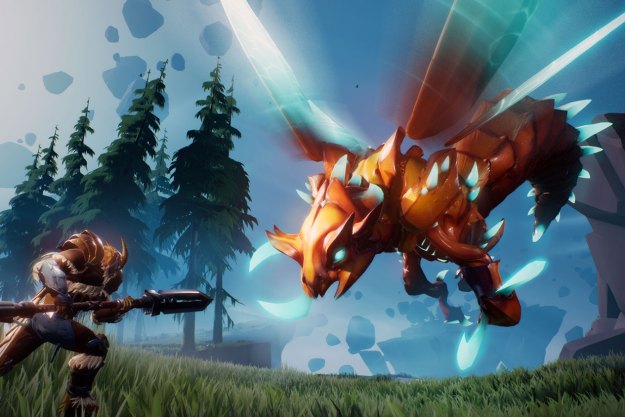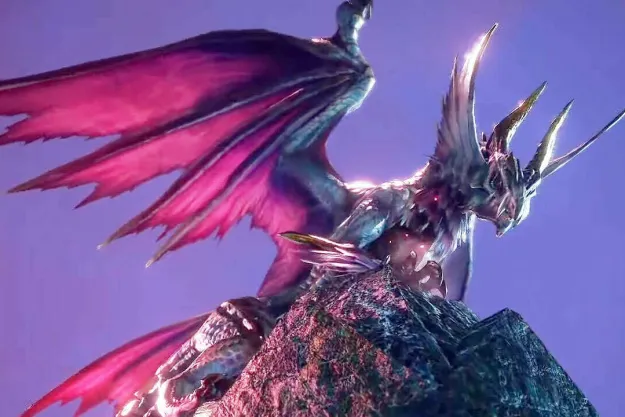
“‘Dauntless’ is a promising take on Capcom’s ‘Monster Hunter’ formula, brought to PC by former Riot devs.”
- Crisp, stylized visuals
- Wider platform for niche genre
- Fun, visceral, cooperative combat
- Clunky UI
After years of being relegated to handheld consoles, the Monster Hunter experience is finally coming to big-screen platforms. At long last, western players will be able to hunt giant monsters with friends, and use their corpses to craft weapons and armor to hunt even bigger monsters on the platforms they prefer.
No, we aren’t talking about Monster Hunter World, Capcom’s upcoming home console adaptation coming in January, 2018. We’re talking about Dauntless, a free-to-play action RPG from indie studio Phoenix Labs, which takes the Monster Hunter formula — hunt, craft, repeat — and adapts it for a wider audience.
Monster Hunter, which is extremely popular in Japan and has a smaller, devoted following in the U.S., is known for, among other things, time consuming missions and obtuse crafting mechanics. Dauntless takes the basic gameplay loop and strips out a lot of the complexity with shorter gameplay sessions and radically simplified crafting that won’t have you poring over wiki articles.
The founding core of former League of Legends developer Riot Games staffers at Phoenix Labs means they have ample experience at crafting the sort of systemically-rich, but widely-accessible gameplay that Dauntless needs in order to pull this off.
“It’s about getting together with your friends, slaying these badass, larger-than-life monsters, crafting tons of gear along the way, and having a lot of fun and looking really cool while you do it,” said Phoneix Labs Marketing Manager Nick Clifford.
In closed beta since September, 2017, Dauntless is shaping up to be a viable alternative for players who see how much fun Monster Hunter fans are having, but, for whatever reason, aren’t willing to take the plunge themselves.
Kill the beast!
Dauntless takes place on the Shattered Isles — a fantasy realm spread across a drifting archipelago of floating islands. Giant monsters known as “Behemoths” have always been part of the world, but recent expansions of the frontier have provoked a deadly backlash, bringing horrendous monsters down onto vulnerable settlements. You are a Slayer, whose order has hunted behemoths for generations and is needed now more than ever. The game features a narrative campaign that unlocks progressively more difficult areas and behemoth hunts, but gameplay is more focused on short sessions than overall progress.
We liked Monster Hunter — we felt like there was a good game in there, but it’s surrounded by a lot of cruft, a lot of unknowable design.
Our journey began in the city of Ramsgate, which serves as an MMO-style social hub where you can meet up with friends, craft gear, change your appearance, or take on new hunts. Ramsgate feels more like an old-school MMO public space than something you’d find in, say, Destiny 2: It’s populated with up to 60 real players (starting with your friends, followed by your guild, and then filling in the rest with people geographically close to you). Players will also be able to connect with friends or through standard matchmaking, so you’re never limited in with whom you can play.
The hunt itself took place on one of the floating islands, traveled to in a loading screen via airship. On landing, our three-person party set out to find our first behemoth. After several minutes of running around, one of our party found our quarry, “a larger, lumbering pile of rocks” called a Skarn. As promised, Skarn was a huge, quadruped dinosaur encased in thick, stone scales of armor that made it hard to do any real damage.
Fortunately, two of our party wielded heavy mauls, which temporarily knocked the armor off and left an opening for us to run in and hack with our sword. Combat was tense and tactical. Our squadmates, Clifford and Phoenix Labs Community Manager Ian Tornay, both made several allusions to the influence of Dark Souls and Bloodborne on the combat, and it shows in the measured rhythm of mixing light and heavy attacks, while reading your opponents’ animations to anticipate their strikes. The combat also relies heavily on dodge rolls to take advantage of those crucial invincibility frames, moments during an animation when you can’t get hurt, to avoid death while maintaining position.
There are currently five weapon classes in the game, all of which feel and play quite differently. The war pike, for example, deals melee damage builds up energy that you can bank in the pike, before stepping back to unleash in a devastating ranged attack. It’s the closest thing Dauntless has to a ranged weapon — no matter the tactics, you always need to find a way to get in close and land melee hits, making every attack tense and risky.
“Combat fidelity is super important to us,” elaborated Clifford. “When you swing a sword or an axe, it needs to feel really good — really crunchy — when you hit a behemoth.”
Damage numbers pop up to give some feedback of how effective your blows are, but, as in the Monster Hunter games, behemoths don’t display an overall health gauge. Instead, you need read their movements to determine how much damage you’ve done.
“it needs to feel really good — really crunchy — when you hit a behemoth.”
Up to four players can hunt simultaneously, with the behemoth’s challenge scaling to match. The Skarn was a relatively simple prey, asking more endurance than strategy, but even that relatively simple fight required a good amount of communication among our team to take down. Our second hunt with the late game behemoth Caravac showed just how hairy things could get.
The Caravac is a giant insect that can: fly, spawn damaging swarms of smaller insects, cloak itself, and throw out fast, deadly ranged attacks. It wiped our party entirely after a heroic battle. (Clifford reassured us that was par for the course — he’d only beaten it once before in all their testing). The behemoths are designed to push your limits of timing and coordination, demanding more and more teamwork as you pursue deadlier prey.
A late-game monster like the Caravac should normally take three or four attempts to master as you learn its patterns and develop counter-strategies. Again, invoking Dark Souls, framing losing and learning as fun is crucial for the proper Dauntless mindset, which is designed around “highly-replayable, session-based” hunts that should only take 15-20 minutes in total.
Swag
We didn’t get to delve into the second half of the game — crafting and customization — nearly as much as we did the hunt itself, but it’s clear there’s a lot present already. The spoils from each behemoth can produce a complete armor set and one weapon, all of which have unique effects. Players can mix and match (and color customize) their armor piecemeal or wear whole sets, which convey additional bonuses.

This latest patch also introduced a system called “cells”, which add customization sockets in all items. You fill these sockets with the eponymous cells, adding everything from simple buffs, such as resistance to a type of damage, to specific perks, like dealing more damage immediately after a dodge roll.
Dauntless has no classes and minimal character progression (there is a story, but it predominantly exists to unlock new hunts), so gear is the primary means of progression and expression. Cells give players more options to “soft spec” into conventional RPG roles, such as support, tank, or damage-dealer, which might complement their party.
Obtuse crafting with elaborate recipes that require obscure components from multiple monsters has always been one of the more intimidating elements of Monster Hunter for outsiders. Dauntless addresses this by reducing complexity—the crafting system exists to enable customization of your slayer’s look and play style, but it’s supplementary to the main activity of hunting, as opposed to being an almost equally elaborate metagame that sits alongside the actual hunts.
Hunter of Monsters
Dauntless’ similarity to the popular Monster Hunter series of action-RPGs from Japan is no coincidence. A big part of the Dauntless team’s initial impulse from the project came from wanting to strip away all the fat and hone that core experience of co-operative battles against big beasts, creating “a more western-friendly, more accessible action-hunting experience,” according to Clifford.
“We liked Monster Hunter — we felt like there was a good game in there,” explained Clifford, “but it’s surrounded by a lot of cruft, a lot of unknowable design; the DS form factor is always kind of challenging for a hardcore action game; talking cats… There’s a lot about it that I find particularly charming, but it’s difficult to approach for other people.”
Dauntless already makes a great case for approachability. On top of its solid, core mechanics, we really enjoyed its stylized presentation, with bold silhouettes, bright colors, and smooth textures that looked reminiscent of a Blizzard game.
Beyond its charm, the stylized look serves a twofold purpose of allowing the game to run on a wide range of machines and also future-proofing it against graphical obsolescence as fidelity improves — just look at how well the colorful visuals of World of Warcraft held up as so many of its peers looked like muddy garbage in retrospect.
Clifford said that forward-thinking attitude was rooted in their desire to run Dauntless “for many years to come” in the “game-as-service” model. Although it’s too early to say yet whether the game will have that kind of legs, what we saw so far shows great promise. Dauntless is currently in closed PC beta, and will be entering public beta in early 2018.
Editors' Recommendations
- Monster Hunter Wilds: release date speculation, trailers, gameplay, and more
- Xbox Game Pass adds a little and loses a lot this month
- Monster Hunter Rise is coming to PlayStation and Xbox, minus cross-platform saves
- Sonic Frontiers and Monster Hunter cross over with free DLC
- Tokyo Game Show 2022 Capcom showcase: how to watch and what to expect






